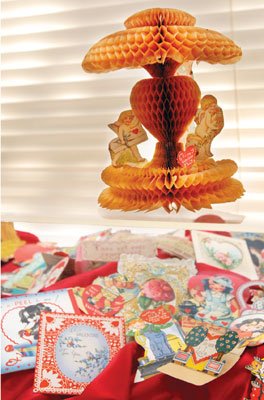Whether you’re exchanging Valentine’s Day gifts with your
beloved sweetheart or your dearest friend, there is one thoughtful
gesture that warms hearts year after year: the valentine card. To
celebrate this long-standing custom, the city of Gilroy is hosting
a special exhibition of antique valentines at the Gilroy
Museum.
Whether you’re exchanging Valentine’s Day gifts with your beloved sweetheart or your dearest friend, there is one thoughtful gesture that warms hearts year after year: the valentine card. To celebrate this long-standing custom, the city of Gilroy is hosting a special exhibition of antique valentines at the Gilroy Museum.
Through the month of April, the museum will be displaying the collection of well-preserved cards, many of which were donated by Gilroy residents.
“They came out of scrapbooks, attics and trunks,” said Susan Voss, recreation coordinator for the Community Services Department. “Culture is something we all live with, sometimes unconsciously.”
The diverse array of cards, dating as far back as 1885, provides a peek at Gilroy’s past through a tradition that has lasted hundreds of years.
“It’s an opportunity to invite the public into the museum and to have them take a lighthearted look at history,” Voss said.
It’s a look that includes letters ranging from romance to friendship, such as the ones given to Winnifred Fitzgerald, the half-sister of the museum founder, Armand White. Born in 1882, she was a descendant of a pioneer Gilroy family and worked as a schoolteacher.
“They were a part of what she saved sentimentally as a teacher – the ones that were too cute to throw away,” Voss said of the Fitzgerald valentines. “Many of that family’s things came into the museum and have found a place in the collection.”
Other valentine cards were acquired from members of the community. Elizabeth Barrett, a board member of the Gilroy Historical Society, donated several that she found preserved between the pages of her mother’s aged Bartlett’s Familiar Quotations book.
“The best one I gave is a beautiful Victorian fold-down that was given to my mother in the 1920s by Stoney Mayock. His family came here about 10 years after the Civil War,” she recounted.
The custom of sending written valentine greetings dates back to the 1400s. The earliest known surviving valentine is a poem penned in 1415 by the imprisoned Charles, Duke of Orleans, to his wife while he was being held in the Tower of London. Handwritten love letters eventually diminished by the end of the 18th century as printing advances began offering affordable cards for the public.
For the Gilroy community, this early communication provides a means to relate to previous generations and understand their stories.
“It shows a time when it was a kinder, gentler, slower lifestyle,” President of the Gilroy Historical Society, Connie Rogers said. “Personal relationships were more valued and Gilroy had a much smaller population then.”
With so much rich history in every letter, the exhibition is proving to incite emotions and memories. Caroline Young made the trip to the museum from her San Martin residence.
“For me, it brings back childhood memories,” she said, remarking further that each card is “just a valentine, instead of the commercialism that there is today.”
At present, about one billion valentines are sent each year worldwide. As opposed to today’s mass-produced bundles of branded valentines boasting the latest television show or video game, these antique cards showcase handcrafted artwork and meticulous designs. A few delicate ‘pinprick’ valentines are available for viewing, in which a pin or needle was used to punch numerous tiny holes in the paper to resemble lace.
In addition to those types of painstaking patterns, other unique cards on display include ‘penny postcards” which were released in the 1800s by creator Charles Howard.
“It’s actually a postcard that cost you a penny – a very cheap and easy way to send your valentine or greeting,” said Voss. For the Valentine’s Day cynics, “There are some that were called ‘vinegar valentines’ that poked fun at feelings, old maids and inept suitors.” Invented by John McLaughlin in 1870, Voss added, “They were sometimes lighthearted and sometimes a bit bitter.”
Even the letters with undertones of sarcasm still possess a sweetness and innocence of the past.
“Then there are some that are just for fun, like the donkey,” Voss added, pointing out a card that reads, ‘Bray-vely asking to be your valentine” with ‘don’t be stubborn’ written on the donkey’s neck and ‘I’ll never kick’ inscribed on the top of his hind legs, which are movable. “That’s an example of a mechanical valentine, which came into vogue around the 1900s.”
From postcards to pop-ups to mechanicals, the antique cards act as a visual timeline of the changing styles that took place across decades, especially in Gilroy. Rogers added, “The valentines are just one way to remind our current residents of the things that were good about our past and connect us today.”
The Gilroy Museum invites residents to bring in their own valentines to be incorporated into the collection. “It’s an opportunity to be part of Gilroy’s history,” said Voss.
The exhibition of antique valentines will be on display through April during the museum hours of Monday, Tuesday, Thursday, Friday, 10 a.m. to 5 p.m., and the first Saturday of the month from 10 a.m. to 2 p.m. For more information, contact the Gilroy Museum at (408) 846-0446 or visit 195 Fifth Street in Downtown Gilroy.
Some historic card inscriptions:
“Bray-vely asking to be your valentine … don’t be stubborn … I’ll never kick” (printed on mechanical donkey card)
“Thou art ever remembered” (threaded into cross-stitch pattern and affixed to piece of ribbon)
“I could travel for a lifetime; Searching every land and race; But I’d never find a teacher; Who could half-way take your place” (printed in letter to Winnifred Fitzgerald and signed ‘From Jim McCandless’)
“You were just cut out to be my valentine … see the point?” (printed on card with picture of a little boy opening a giant pocketknife)














